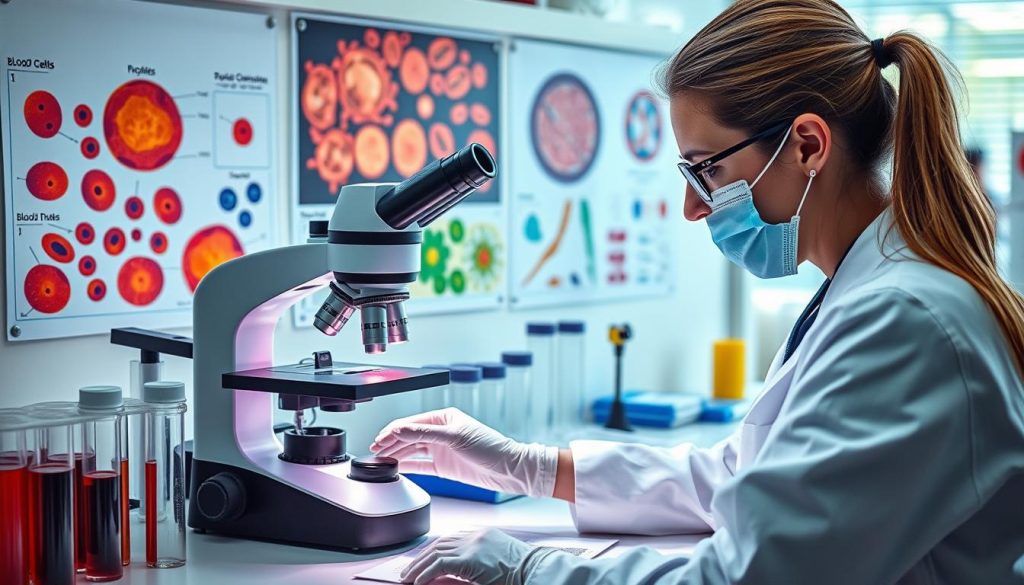The bone marrow is key to our body’s defense and making new blood cells. When we ask, what is bone marrow cancer, we see how serious it is. This tissue in our bones is vital for our health. Bone marrow cancer explained means cancer cells grow in this area, causing problems with blood cell production.
Learning about understanding bone marrow cancer starts with its effect on blood cell creation. Cancer cells grow out of control, taking over the marrow. This disrupts the normal cycle of blood cell life.
The Mayo Clinic sheds light on a bone marrow cancer called multiple myeloma. They share info on symptoms, risks, and treatments. This shows how complex bone marrow cancers can be.
Key Takeaways
- Bone marrow cancer significantly affects the production of healthy blood cells.
- Understanding this condition is crucial for identifying potential health risks and seeking appropriate care.
- Multiple myeloma is one prominent example of how malignancies in the bone marrow manifest.
- The May Clinic’s contributions are vital for those seeking detailed information on bone marrow cancer.
- Recognizing and addressing bone marrow cancer early improves the likelihood of effective treatment and management.
Understanding Bone Marrow and Its Functions
The role of bone marrow in our bodies is more than just a physical space. It’s key for making blood cells and keeping our immune system strong. Let’s explore the details and importance of this vital tissue.
Bone marrow is a spongy tissue inside bones. It’s essential for making new blood cells, like red and white blood cells, and platelets. This process, called hematopoiesis, shows how bone marrow functions are always at work. It keeps our blood supply fresh, helping us breathe, fight off infections, and stop bleeding.
Keeping healthy bone marrow is vital for our daily health and in medical treatments. It’s crucial for things like transplants and recovering from blood-related illnesses. Here’s a closer look at the cells bone marrow makes and what they do:
| Cell Type | Function |
|---|---|
| Red Blood Cells (Erythrocytes) | Transport oxygen from the lungs to the body and carbon dioxide back to the lungs for expulsion. |
| White Blood Cells (Leukocytes) | Key players in the immune system, protecting against infection and foreign bodies. |
| Platelets (Thrombocytes) | Essential in blood clotting and control of bleeding. |
The role of bone marrow is closely tied to our immune system’s health. Doctors often check the marrow’s health to find blood disorders and cancers.
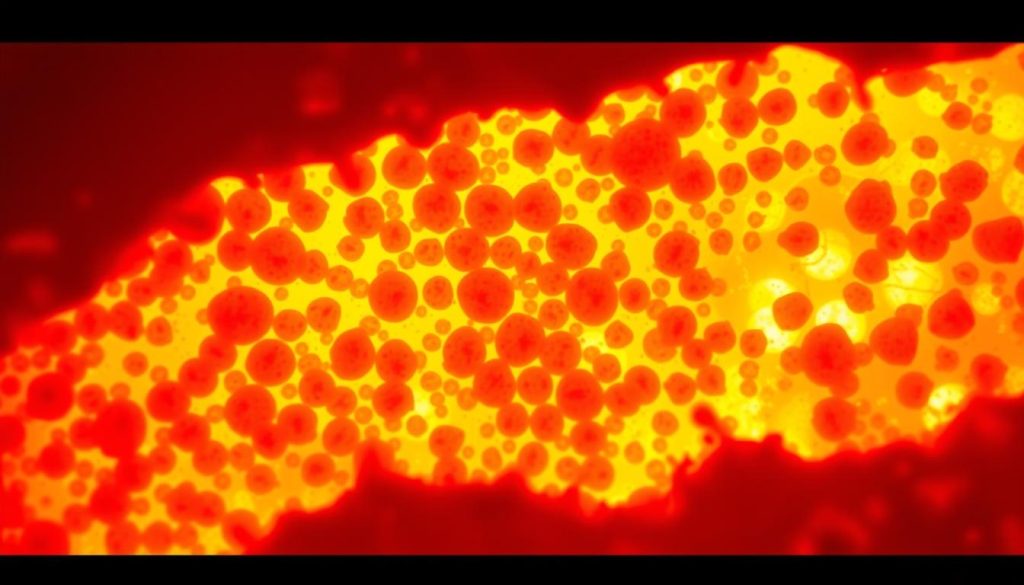
Keeping bone marrow healthy is key for our body’s strength and how well we respond to treatments. Understanding this helps us see how diseases like bone marrow cancer affect these important functions.
What Is Bone Marrow Cancer?
Bone marrow cancer is a type of cancer that starts in the bone marrow. This is the soft, spongy tissue inside bones. It’s where healthy blood cells are made. When cancer disrupts this process, it can cause serious health problems.
The bone marrow cancer impact on the body is significant. It can lead to a big drop in healthy blood cells. This makes the body more likely to get infections, anemia, and have bleeding issues.
Understanding how cancer cells affect blood cell production is key in diagnosing bone marrow cancer. Cancer cells grow fast and take over, stopping healthy cells from working right. Tests can show how much the cancer affects normal marrow function.
To learn more about bone marrow cancer, check out this resource on types and symptoms.
- Decreased red blood cells leading to fatigue and weakness
- Reduced white blood cells leading to increased infection risk
- Lower platelets causing bleeding and bruising easily
Early detection of bone marrow cancer can greatly improve treatment outcomes. Treatments often include chemotherapy, radiation, and sometimes stem cell transplants. These aim to get healthy bone marrow back.
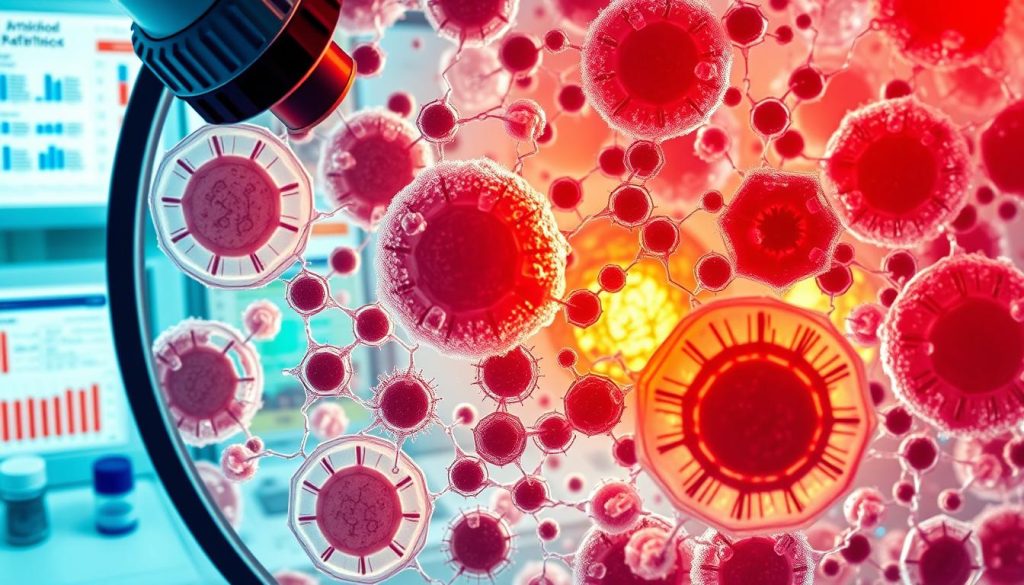
| Component | Normal Function | Impact of Cancer |
|---|---|---|
| Red Blood Cells | Carry oxygen to all body parts | Reduces oxygen transport, causing fatigue |
| White Blood Cells | Fight infections | Increased risk of serious infections |
| Platelets | Help in blood clotting | Reduced clotting leads to excessive bleeding |
Understanding bone marrow cancer diagnosis helps grasp the disease’s progression. It also highlights important moments for intervention to fight the disease more effectively.
Differentiating Between Bone Marrow Cancer Types
It’s important to know about the different bone marrow cancer types for proper diagnosis and treatment. Each type has its own traits and affects the body in unique ways. We’ll look at leukemia, myeloma, and lymphoma, explaining how they show up and affect patients.
Leukemia: Blood Formation Gone Wrong
Leukemia is a bone marrow cancer where the body makes too many bad blood cells. It starts in the blood-making tissue. This leads to trouble fighting off infections and carrying oxygen.
Myeloma: Cancer of the Plasma Cells
Myeloma attacks the plasma cells, which are key for a strong immune system. In this cancer, bad plasma cells take over the bone marrow. This weakens the immune system and causes many problems.
Lymphoma: Cancer in the Lymphatic System
Lymphoma hits the lymphatic system, but it’s also linked to the bone marrow. It can start in lymph nodes or other organs before spreading to the bone marrow.
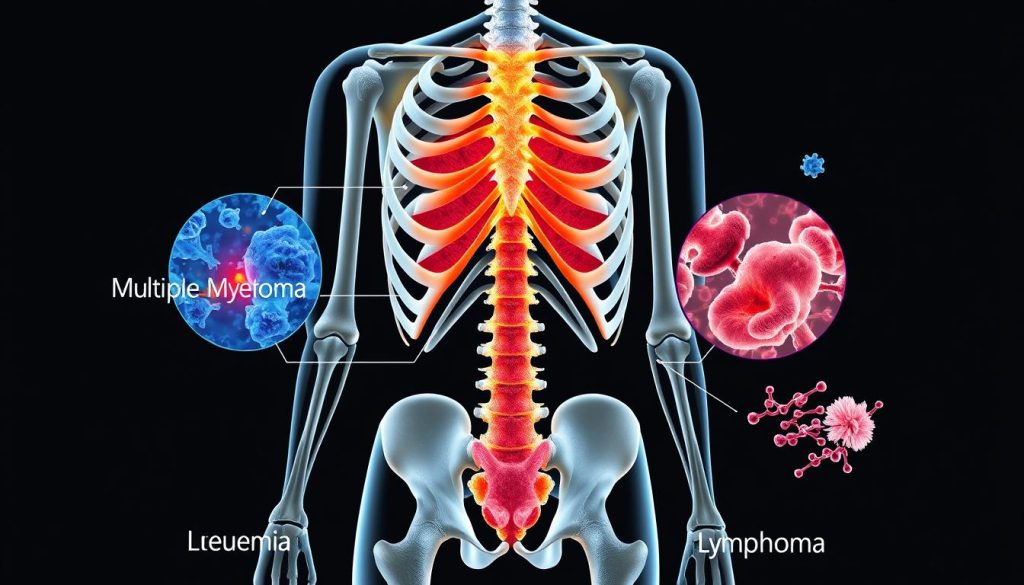
| Cancer Type | Primary Impact Area | Key Characteristics |
|---|---|---|
| Leukemia | Blood and bone marrow | Overproduction of defective blood cells |
| Myeloma | Bone marrow | Abnormal plasma cells, weakens immune response |
| Lymphoma | Lymphatic system and bone marrow | Begins in lymphatic tissues, potentially invades bone marrow |
This breakdown helps us understand how these cancers start. It also guides us in creating treatments that focus on the right areas. Knowing if someone has leukemia, myeloma, or lymphoma is key to choosing the right treatment and predicting how well they’ll do.
Recognizing the Symptoms of Bone Marrow Cancer
It’s important to know the bone marrow cancer symptoms and signs of bone marrow cancer for early treatment. We’ll look at the symptoms of this disease. These include both main and secondary signs.
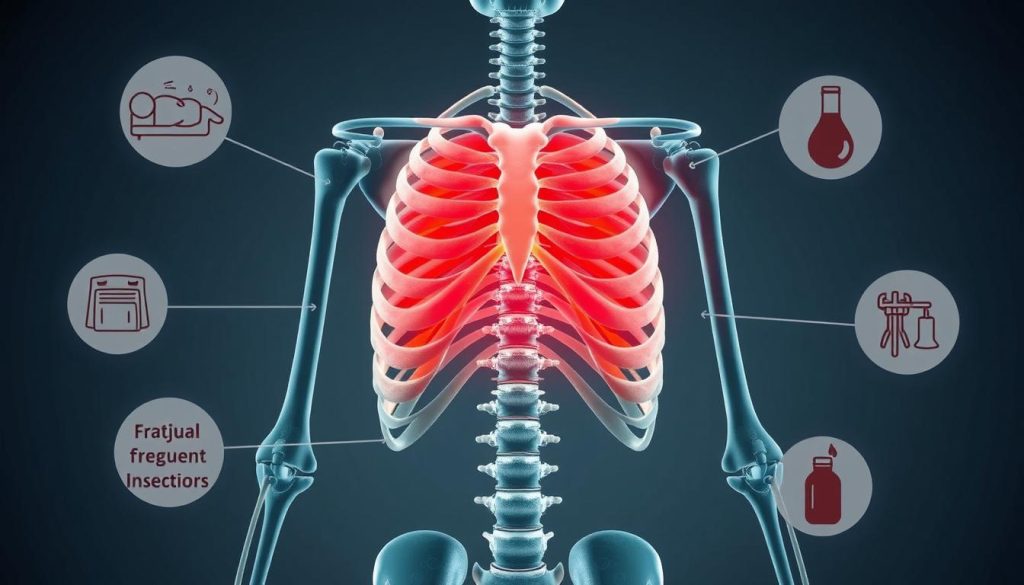
Primary symptoms often start quietly and can be missed. These bone marrow cancer symptoms are key signs that need medical check-ups.
- Anemia leads to constant tiredness and weakness.
- Frequent infections happen because the immune system is weak.
- Unexplained bruising or bleeding shows trouble with blood clotting.
- Fever or night sweats suggest a body-wide problem.
Secondary symptoms become clearer as the cancer grows. Spotting these signs of bone marrow cancer helps tell it apart from milder conditions.
- Bone or joint pain happens when cancer cells take over.
- Weight loss and less appetite are often unexplained.
- Swelling in the abdomen can happen if spleen or liver are affected.
- Difficulty breathing or a persistent cough can occur if cancer affects the chest.
Knowing these symptoms helps doctors and patients spot signs of bone marrow cancer early. Early detection is crucial for managing and possibly beating this tough disease.
Exploring the Causes of Bone Marrow Cancer
The causes of bone marrow cancer are complex, involving genetics and the environment. By studying these factors, we can better understand how to prevent and treat the disease.
Genetic Factors and Mutations
Research shows that mutations play a key role in bone marrow cancer. These changes can be inherited or happen on their own. They affect how bone marrow cells work, leading to cancer.
This mix of inherited and spontaneous mutations makes bone marrow cancer hard to predict. It shows how complex the disease’s causes are.
Environmental and Lifestyle Influencers
Things outside our bodies also affect bone marrow cancer risk. Radiation, harmful chemicals, and pesticides can increase the risk. Smoking and secondhand smoke exposure also play a part.
Each of these factors can contribute to the disease. This makes it crucial to keep researching their effects.
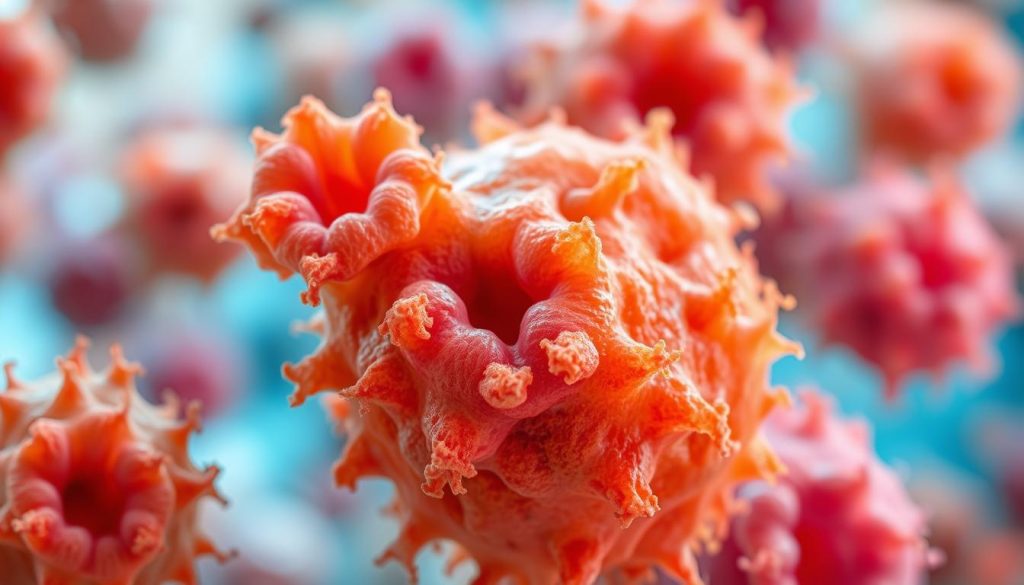
- Study of genetic predisposition to mutations in bone marrow cells
- Analysis of environmental toxins and their link to cancer risk
- Lifestyle effects, such as diet and exposure, on bone marrow health
Understanding the mix of genetics and environmental factors is key. It helps us find ways to prevent and treat bone marrow cancer.
Identifying Bone Marrow Cancer Risk Factors
Understanding the factors that lead to bone marrow cancer is key. This includes age, genetics, and lifestyle. Knowing these can help spot and manage the disease early.
Age and Its Impact on Bone Marrow Function
Age affects bone marrow health a lot. As we get older, our bone marrow works less well. This makes it more likely to develop problems and cancers.
The older we get, the harder it is for bone marrow to fix itself. This makes it more prone to growing abnormally.
Family History and Genetic Predisposition
Having a family history of bone marrow cancer raises your risk. Genetic mutations passed down through generations can cause cancer. This is a big clue for doctors to watch for.
Lifestyle: Diet and Exposure to Radiation
Our lifestyle choices can also raise cancer risk. Bad diets and radiation exposure are big concerns. Foods that cause inflammation or have harmful substances can be risky. So can radiation from treatments or the environment.
These factors all play a part in how likely you are to get bone marrow cancer. By understanding them, we can work on prevention. This includes focusing on aging, genetics, and lifestyle to lower risk and catch cancer early.
How Bone Marrow Cancer Is Diagnosed
Diagnosing bone marrow cancer involves several steps and tests. Specialists in hematology and oncology are key. They help detect bone marrow cancer and understand its extent and stage.
First, doctors review the patient’s medical history and run lab tests. Blood tests are crucial. They can show if there are problems with blood cell counts, hinting at cancer.
The bone marrow biopsy is a direct method. It takes a small sample from the hipbone. This sample is then checked under a microscope for cancer cells.
- Complete Blood Count (CBC): Serves as an initial check to assess the levels and appearance of various blood cells.
- Bone Marrow Biopsy: Essential for evaluating the physical characteristics and any mutations in cells.
- Imaging Tests: Include X-rays, PET scans, or MRIs to detect abnormal bone structures or areas of active cancer growth.
Advanced imaging tests also help in detecting bone marrow cancer. Tests like X-rays and MRI scans show abnormal bone growth or tumors. PET scans are especially useful. They spot areas with high cell activity, often where cancer is present.
Doctors use the patient’s history, physical exams, and tests to accurately diagnose and stage bone marrow cancer. This helps them create the best treatment plans.
Comprehensive Treatment Options for Bone Marrow Cancer
Significant progress has been made in treating bone marrow cancer. This includes chemotherapy, radiation therapy, and stem cell transplants. Each method plays a key role in fighting this serious disease.
Chemotherapy: Systemic Cancer Treatment
Chemotherapy is a mainstay in treating bone marrow cancer. It kills cancer cells all over the body. This is especially true for cancers like leukemia, which spreads quickly.
Chemotherapy drugs are given through an IV or orally. They aim to stop cancer cells from growing and spreading.
Radiation Therapy: Targeting Cancer Cells
Radiation therapy uses high-energy rays to kill cancer cells in specific areas. It’s used when bone marrow cancer forms solid tumors or is localized. This method helps protect healthy tissues and reduces side effects.
Stem Cell Transplant: Rebuilding the Bone Marrow
A stem cell transplant can cure some bone marrow cancers. It allows doctors to use strong chemotherapy and then replace damaged bone marrow. Healthy stem cells come from the patient or a donor.
These cells are infused into the patient’s bloodstream. They start to make new bone marrow, helping the body make blood cells again.
These treatments work together to fight bone marrow cancer. Each has its own benefits and is often used together. Ongoing research aims to improve these treatments and find new ones for better patient outcomes.
Prognosis of Bone Marrow Cancer: Factors Affecting Outcomes
The bone marrow cancer prognosis depends on many factors. Each factor is crucial in determining cancer survival rates and outcomes. Knowing these factors helps both patients and healthcare providers.
The type and stage of cancer at diagnosis are key. Early detection leads to better chances and more effective treatments. The patient’s age, overall health, and how well the cancer responds to treatment also matter a lot.
Here are some statistics from top medical institutions. They show how different cancer survival rates can be based on important factors:
| Type of Bone Marrow Cancer | 5-Year Relative Survival Rate |
|---|---|
| Leukemia (All types) | 68% |
| Multiple Myeloma | 54% |
| Non-Hodgkin Lymphoma | 74% |
This table gives a glimpse of survival rates. But, personalized treatment plans and new medical discoveries are key to better cancer outcomes. Every case is different, and these stats are just a guide, not a guarantee.
- Patient’s Age: Younger patients usually have better chances because they are healthier.
- Type of Cancer: Some bone marrow cancers are more aggressive and harder to treat.
- Advances in Medical Research: New treatments and therapies can greatly improve survival rates.
The prognosis of bone marrow cancer is complex and keeps changing. It’s shaped by many personal factors and the latest in medical science.
Preventative Measures and Early Detection of Bone Marrow Cancer
Fighting bone marrow cancer starts with taking action early. It’s important to prevent and detect it early to save lives. This part talks about how to prevent and detect bone marrow cancer early.
The Role of Regular Health Screenings
Regular health checks are key to catching bone marrow cancer early. Doctors suggest blood tests to spot unusual cell counts. These tests can find cancer early, when it’s easier to treat.
Lifestyle Adjustments for Prevention
Living a healthy lifestyle helps prevent bone marrow cancer. Here are some tips:
- Eat a diet full of antioxidants and avoid processed foods.
- Stay active to keep your immune system strong.
- Limit exposure to harmful chemicals like benzene.
These habits not only keep you healthy but also lower cancer risk, including bone marrow cancer.
The Importance of Awareness and Education
Knowing about bone marrow cancer is vital. When people are informed, they’re more likely to get checked and take steps to prevent it. Learning comes from health seminars, brochures, and online resources.
In summary, early detection, a healthy lifestyle, and education are crucial. By working together, we can fight bone marrow cancer better. This can lead to better health outcomes and lower cancer rates worldwide.
Conclusion
We’ve explored the complex world of bone marrow cancer, aiming to offer both understanding and hope. We’ve looked at the disease’s details, from bone marrow’s role to the different cancers it can host. This summary helps you understand why early detection and symptoms are crucial.
Medical progress has brought new treatments to the table. Options like chemotherapy, stem cell transplants, and radiation therapy offer hope. We also talked about how to prevent cancer, highlighting the importance of lifestyle changes and education.
The fight against bone marrow cancer is filled with challenges but also hope. It’s a journey marked by medical advancements, support, and informed choices. Let’s move forward together, armed with knowledge and compassion, building a supportive community.
FAQ
Q: What exactly is bone marrow cancer?
A: Bone marrow cancer is a type of cancer that affects the bone marrow. This is the soft, spongy tissue inside your bones. It’s where blood cells are made. Cancer can mess up this process, causing health problems.
Q: Can you describe the natural functions of bone marrow?
A: Bone marrow makes red blood cells, white blood cells, and platelets. These are key for carrying oxygen, fighting infections, and clotting blood. It’s crucial for our immune system and health.
Q: How does bone marrow cancer impact the body?
A: Bone marrow cancer stops it from making healthy blood cells. This can lead to anemia, more infections, and clotting issues. It can really hurt someone’s quality of life.
Q: What are the different types of bone marrow cancer?
A: There are several types. Leukemia starts in blood-forming tissues. Myeloma affects plasma cells. Lymphoma begins in the lymphatic system and can affect bone marrow too.
Q: How can one recognize the symptoms of bone marrow cancer?
A: Symptoms include fatigue, bone pain, and frequent infections. You might also feel anemic, lose weight, bruise easily, or bleed a lot. Spotting these signs early is key for treatment.
Q: What causes bone marrow cancer?
A: Causes include genetic mutations and environmental factors. Lifestyle choices like toxic chemical exposure or radiation can play a role. Often, the exact cause is unknown.
Q: What are the risk factors for developing bone marrow cancer?
A: Risk factors include getting older, having a family history, and certain lifestyle choices. Diet and radiation exposure are examples.
Q: How is bone marrow cancer diagnosed?
A: Diagnosis involves blood tests, bone marrow biopsies, and imaging tests. Specialists in hematology and oncology help figure out the disease’s nature and extent.
Q: What are the treatment options for bone marrow cancer?
A: Treatments include chemotherapy, radiation, and stem cell transplants. The right treatment depends on the cancer type, stage, and the patient’s health.
Q: What factors affect the prognosis of bone marrow cancer?
A: Prognosis depends on the cancer type and stage, the patient’s age and health, and how well the cancer responds to treatment.
Q: How can one prevent or detect bone marrow cancer early?
A: Preventing it means making healthy lifestyle choices. Early detection comes from regular health checks and knowing the symptoms. This way, you can get medical help quickly.
Q: What measures can be taken for the prevention of bone marrow cancer?
A: While not all cases can be prevented, a healthy lifestyle helps. Avoiding carcinogens and regular check-ups are good steps. Education and awareness are key to prevention and early detection.












